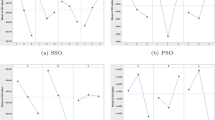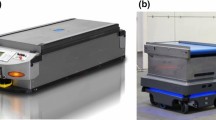Abstract
In recent years, volatile markets have given rise to a new production system, seru production system, which has been widely utilized in the Asian electronics industry and considered as the next generation of lean production. This paper focuses on the configuration of a seru production system considering that (1) serus are physically reconfigurable rather than fixed and (2) workers have different skill ranges and processing velocities. A mathematical model, whose objectives are to minimize the total completion time and to minimize the total labor cost, is constructed. An improved multiobjective algorithm that combines a multiobjective genetic algorithm, differential evolutionary algorithm and conflict-factor-based mutation operator is proposed in this paper. Computational experiments show that our proposed algorithm outperforms classic scheduling heuristics and well-known algorithms.





Similar content being viewed by others
References
Yin Y, Stecke KE, Li D (2018) The evolution of production systems from industry 2.0 through industry 4.0. Int J Prod Res 56(1-2):848–861
Gong J, Norio I, Sadami S (2014) New product development operational performance and its influential factors: cross-national comparison between Japan and China. Asian J Manag Sci Appl 1(3):237–260
Kambara H (2016) Outsourcing and performance in Japanese manufacturing firms. Asian J Manag Sci Appl 2(4):376–393
Wang JW, Muddada RR, Wang HF, Ding JL, Lin Y, Zhang WJ (2016) Towards a resilient holistic supply chain network system: concept, review and future direction. IEEE Syst J 10(2): 410–421
Wang JW, Dou RL, Muddada RR, Zhang WJ (2018) Management of a holistic supply chain network for proactive resilience: theory and case study. Comput Ind Eng 125:668–677
Stecke KE, Yin Y, Kaku I, Murase Y (2012) Seru: the organizational extension of JIT for a super-talent factory. Int J Strategic Decis Sci 3(1):105–118
Koren Y, Heisel U, Jovane F, Moriwaki T, Pritschow G, Ulsoy AG, Van Brussel H (1999) Reconfigurable manufacturing systems. CIRP Ann 48(2):6–12
Bi ZM, Lang SYT, Shen W, Wang L (2008) Reconfigurable manufacturing systems: the state of the art. Int J Prod Res 46(4):967–992
Hsieh F-S (2021) A dynamic context-aware workflow management scheme for cyber-physical systems based on multi-agent system architecture. Appl Sci 11(5):20–30
Hsieh F-S (2018) Design of scalable agent-based reconfigurable manufacturing systems with Petri net. Int J Comput Integr Manuf 31(8):748–759
Roth A, Singhal J, Singhal K, Tang CS (2016) Knowledge creation and dissemination in operations and supply chain management. Prod Oper Manag 25(9):1473–1488
Yin Y, Stecke KE, Swink M, Kaku I (2017) Lessons from, seru, production on manufacturing competitively in a high cost environment. J Oper Manag 49-51:67–76
Yin Y, Kaku I, Stecke K (2008) The evolution of production systems throughout canon. Oper Manag Educ Rev 2:27–40
Liu CG, Stecke KE, Lian J (2014) An implementation framework for production. Int Trans Oper Res 21(1):1–19
Stecke KE, Yin Y, Kaku I (2014) Production: an extension of just-in-time approach for volatile business environment. J Obstet Gynaecol Res 40(6):1725–1732
Zhang XL, Liu CG, Li WJ, Evans S, Yin Y (2017) Effects of key enabling technologies for seru production on sustainable performance. Omega 66:290–307
Yu Y, Wang JW, Ma K, Sun W (2018) Seru system balancing: definition, formulation, and solution. Comput Ind Eng 122:318–325
Yu Y, Tang JF (2019) Review of seru production. Front Eng Manag 6(2):183–192
Sun W, Yu Y, Lou Q, Wang JW, Guan YC (2019) Reducing the total tardiness by seru production: mode, exact and cooperative coevolution solutions. Int J Prod Res 58(21):6441–6452
Abdullah M, Süer GA (2019) Consideration of skills in assembly lines and seru production systems. Asian J Manag Sci Appl 4(2):99–123
Li D, Zhan R, Zheng D, Li M, Kaku I (2016) A hybrid evolutionary hyper-heuristic approach for intercell scheduling considering transportation capacity. IEEE Trans Auto Sci Eng 13(2):1072–1089
Li D, Zhan R, Du S, Wu X, Wang S (2019) Automatic design of intercell scheduling heuristics. IEEE Trans Auto Sci Eng 99:1–15
Liu CG, Yang N, Li WJ, Lian J (2013) Training and assignment of multi-skilled workers for implementing seru production systems. Int J Adv Manuf Technol 69(5-8):937–959
Liu CG, Dang F, Li WJ, Lian J, Evans S, Yin Y (2014) Production planning of multi-stage multi-option seru production systems with sustainable measures. J Clean Prod 105:285–299
Lian J, Liu CG, Li WJ, Yin Y (2018) Multi-skilled worker assignment in, seru, production systems considering worker heterogeneity. Comput Ind Eng 118:366–382
Yu Y, Tang JF, Gong J et al (2014) Mathematical analysis and solutions for multi-objective line-cell conversion problem. Eur J Oper Res 236(2):774–786
Yu Y, Tang J, Sun W, Yin Y, Kaku I (2013) Combining local search into non-dominated sorting for multi-objective line-cell conversion problem. Int J Comput Integr Manuf 26(4):316–326
Yu Y, Tang J, Sun W, Yin Y, Kaku I (2013) Reducing worker(s) by converting assembly line into a pure cell system. Int J Prod Econ 145(2):799–806
Yu Y, Sun W, Tang J, Kaku I, Wang J (2017) Line-seru conversion towards reducing worker(s) without increasing makespan: models, exact and meta-heuristic solutions. Int J Prod Res 55(10):2990–3007
Yu Y, Sun W, Tang JF et al (2017) Line-hybrid seru system conversion: models, complexities, properties, solutions and insights. Comput Indust Eng 103 (2017):282–299
Yilmaz OF (2019) Operational strategies for seru production system: a bi-objective optimisation model and solution methods. Int J Product Res 58(11):3195–3219
Weglarz J, Józefowska J, Mika M, Waligóra G (2011) Project scheduling with finite or infinite number of activity processing modes - a survey. Eur J Oper Res 208(3):177–205
Mokotoff E (2004) An exact algorithm for the identical parallel machine scheduling problem. Eur J Oper Res 152(3):758– 769
Salimifard K, Mohammadi D, Moghdani R, Abbasizad A (2019) Green fuzzy parallel machine scheduling with sequence-dependent setup in the plastic moulding industry. Asian J Manag Sci Appl 4(1):27–48
Fanjul-Peyro L, Perea F, Ruiz R (2017) Models and matheuristics for the unrelated parallel machine scheduling problem with additional resources. Eur J Oper Res 260(2):482–493
Krzysztof F, Khalil S (2018) Algorithms for the unrelated parallel machine scheduling problem with a resource constraint. Eur J Oper Res 271(3):839–848
Storn R, Price K (1997) Differential evolution–a simple and efficient heuristic for global optimization over continuous spaces. J Glob Optim 11(4):341–359
Marimuthu S, Sait AN (2013) Performance evaluation of proposed differential evolution and particle swarm optimization algorithms for scheduling m-machine flow shops with lot streaming. J Intell Manuf 24 (1):175–191
Liu Y, Yin M, Gu W (2014) An effective differential evolution algorithm for permutation flow shop scheduling problem. Appl Math Comput 248:143–159
Vincent LWH, Ponnambalam S, Kanagaraj G (2014) Differential evolution variants to schedule flexible assembly lines. J Intell Manuf 25(4):739–753
Dechampai D, Tanwanichkul L, Sethanan K, Pitakaso R (2017) A differential evolution algorithm for the capacitated VRP with flexibility of mixing pickup and delivery services and the maximum duration of a route in poultry industry. J Intell Manuf 28(6):1357–1376
Wu X, Che A (2019) A memetic differential evolution algorithm for energy-efficient parallel machine scheduling. Omega 82(1):155–165
Yuan S, Li T, Wang B (2021) A discrete differential evolution algorithm for flow shop group scheduling problem with sequence-dependent setup and transportation times. J Intell Manuf 32(2):427–439
Deb K, Pratap A, Agarwal S, Meyarivan T (2002) A fast and elitist multiobjective genetic algorithm: NSGA-II. IEEE Trans Evol Comput 6(2):182–197
Donohue JM, Aczel AD, Freund JE, Williams FJ, Perles BM (2002) Complete business statistics. American Statian 47(4):309
Author information
Authors and Affiliations
Corresponding author
Additional information
Publisher’s note
Springer Nature remains neutral with regard to jurisdictional claims in published maps and institutional affiliations.
Rights and permissions
Springer Nature or its licensor holds exclusive rights to this article under a publishing agreement with the author(s) or other rightsholder(s); author self-archiving of the accepted manuscript version of this article is solely governed by the terms of such publishing agreement and applicable law.
About this article
Cite this article
Zhan, R., Li, D., Ma, T. et al. Configuring a seru production system to match supply with volatile demand. Appl Intell 53, 12925–12936 (2023). https://doi.org/10.1007/s10489-022-04097-9
Accepted:
Published:
Issue Date:
DOI: https://doi.org/10.1007/s10489-022-04097-9




